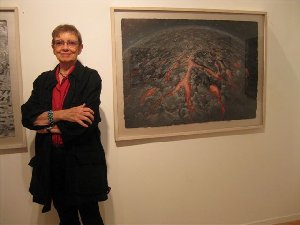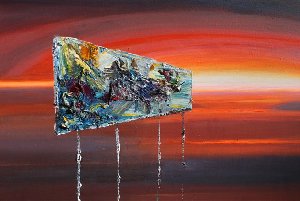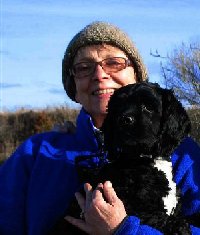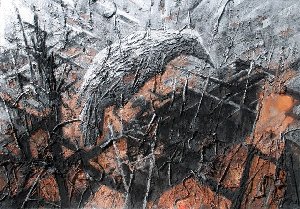|
JANET CULBERTSON - ECO ARTIST/ACTIVIST

I was born in the small town of Greensburg, in Western Pennsylvania. My fascination with the world of art began
when I was four and watched a teacher draw a perfect arc, Mickey Mouse ears, on paper with a pencil. I spent my
childhood coloring, drawing on my blackboard, and modeling in clay. Small town life was closely involved with nature,
climbing trees, hiking fern filled woods, raising dogs, canoeing and visiting a relative's farm. Here I churned
butter, milked cows, and on rainy days read through a series of Mark Twain's works. My mother channeled her energy
into raising three children. My father, an engineer, was a gun collector and hunter. Every fall he brought home
dead, bloody animals from the kill. I failed to come to terms with the ubiquitous hunting mentality of small town
life, and from this experience came to feel that nature and her creatures were sacred. I became a pantheist without
knowing it.
My parents respected my passion for art and sent me to an art class taught by Dorothy
Riester a sculptor, feminist and graduate of Carnegie Tech. She introduced me to a greater awareness of the world,
instilled in me that art was a way of life, that women had a right to a career, and I should go to Carnegie Tech
to study art. During high school I continued art classes, entered poster contests (where I often won an award),
and became the yearbook artist. I was delighted to be accepted at Carnegie Tech as a painting and drawing student
in 1949. From that moment, my commitment to art having been validated, was total and has remained so to this day.
At Carnegie, one of my teachers was Balcomb Greene. I became exhilarated by the unconventional ideas and free life
style described by his wife Gertrude. We all lived in a run down mansion on Pittsburgh's Fifth Avenue in rented
rooms. I was a serious student, grappling with all manner of technical disciplines and expressionistic ideas. During
my first year there, were influential painters Philip Pearlstein and Andy Warhol as graduates. It was a good but
tough four years. After college I came to New York City because we were told it was the "Art center of the
World". For the next several years I struggled to paint, while working at jobs such as stringing beads, parking
cars, and doing display sculpture. I socialized at the White Horse Tavern, married and divorced a Czechoslovakian
refugee and finally fell into a real job that swallowed years, textile design. My art reflected my life at this
time; erratic and experimental with wildly expressionistic images of screaming figures. To stay involved with art,
I took classes at the Art Students League with Vaclav Vytlacil and Harry Sternberg, and with Howard Conant at NYU.
These were generous and encouraging teachers. The textile field was devouring, although I was promoted as a stylist
and managed a small design department. (I could never get the message that "only what sold was good").
That work paid for my Master of Arts degree, which I earned during my vacations and four years of night classes.
I received my degree from NYU and found a job at Pace College teaching painting and art history. This was a high
point for me; I was getting my life together, had a sense of accomplishment, and had time to paint intensively.
Islip Show 2010
 |
In 1964 I met and married Douglas Kaften, a textile manager, photographer, and divorced
father of three. (We subsequently supported and put his children through college, together pooling our resources.)
My work at this time consisted of painted and textured collage papers that I assembled into images of oil slicked
animals. These works were shown in NYC at the 20th Century West Gallery in my first exhibit (1967) called "Elegy
to Nature".
In 1968 Douglas' job took us to California, where I felt wrenched away from my roots and dealt with this by doing
a series of silverpoint drawings of home-town life inspired by the faded, mysterious photographs in our family
album. I completed a series of 25 works, walked into the Molly Barnes Gallery in Los Angeles and to my amazement
was instantly offered an exhibition. This series sold well and was reviewed. (Ten of these are now in the collection
of the Telfair Museum of Art in Savannah, Georgia with more promised by three of my collectors).
During the following two years I painted and explored the West, taking trips to the desert, redwoods, canyons and
Mexico. When Doug's job took us back to New York City, I resumed teaching at Pace College, as well as several drawing
courses at Pratt Art Institute. I went to the Lerner-Heller Gallery, with more silverpoint drawings and was offered
an exhibition within two months.3 These works were exhibited again in Atlanta, Georgia, at the Midtown Gallery.
In retrospect I feel they were my most pleasing works, deeply felt, but not my best. I needed to return to nature.
I was fascinated by the slivers of islands on Eastern Long Island and painted these from a small boat using a minimal
style that reflected their pared down shimmering, mirage-like simplicity. This series was also well received and
was exhibited at the Lerner-Heller gallery in 1973 as well other venues on the East End.

Nature painting in the 70's "wasn't in" especially in New York City. To
rethink my philosophy and perhaps to reinforce or strengthen my beliefs, I began a quest, reading Joseph Campbell's
Hero with a Thousand Faces and other similar writings. 4 I became involved in the women's movement and began to
create a personal myth with the woman as protagonist and heroine, not passive observer. I developed a series of
drawings composed of an imploded ink surface, I found a way to break apart India ink, which paralleled what I felt
was happening to the landscape. I drew upon them with charcoal depicting my version of the Monomyth. It was a search
for a personal truth, climaxing in a merging with the Redwood tree, symbol of nature in its ancient, most powerful
form. I still believe Nature and her creatures are sacred. To Lerner these ideas weren't "saleable."
In spite of this, I felt a conviction about my subject. Later this series of 20 drawings was collected by the National
Museum of Women in the Arts in Washington DC. In 2005 they gave me an exhibition of my Mythmaker series, shown
in sequence for the first time. I was gratified to have this work reach a larger group of viewers with its idea
about the effectiveness of the expanding role of women as protectors of the earth.
My search led me to the Galapagos Islands, to experience this primordial place, and to paint it. I was inspired
by Melville's and Darwin's haunting accounts. I joined a group of environmentalists called Friends of the Earth,
and spent three weeks there in February, 1975. We camped, sailed, and hiked, while I painted and took photographs.
I was entranced by the grand, barren beauty of these now endangered islands. I was jolted into doing larger work,
a series of mural-sized drawings of the monumental tortoises, iguanas, and trees as well as paintings of the lava-formed
islands. (These drawings utilized the ink technique I developed in the myth series). I felt a synthesis of my work
coming together. These paintings and drawings were exhibited in the Lerner-Heller Gallery in 1977 and in other
museum shows and alternative spaces. 
My wilderness experiences fueled my sense of awe and concern for the earth. I saved every penny I could for these
trips. In 1979, I was happy to receive a C.A.P.S. graphics award for my large drawings, (tortoise etc.) which I
used for rafting trips in the Grand Canyon. I developed a Canyon series, collages of ink textured papers with flat
shapes and carved beveled white edges. I worked on creating a spaceless anxiety, a loss of the eternal as I saw
the Grand Canyon threatened by a dam project. I did more large drawings such as "Tanker in the grand Canyon"
and animals of that area. Each of these works came from a personal encounter or in some cases from a dream, a nightmare
or newspaper account.
I felt convinced that women could have a stronger role in saving the world from ecological disaster and proposed
with Lucy Lippard and several other women an idea for a Heresies magazine issue linking feminism and ecology. My
article on ECOTAGE appears in issue #13, published in 1981. The word Eco-Feminism was created.
A personal apocalypse occurred for me In December, 1980. The Lerner Gallery dropped
me, a dear friend died and I was seriously injured in a car accident. The accident was shattering physically (a
broken pelvis and ribs, a collapsed lung, concussion and contusions, etc. six weeks in the hospital) but it was
the combination of losses that affected me deeply. I had another exhibit scheduled that February at the Nardin
Gallery in New York City of my Canyon series. Although I was immobilized, and unable to attend my opening, my husband
framed and delivered the work.(reviewed by The New York Times.)

My recuperation from the accident came slowly from several encounters with nature. I began digging in the earth
planting bulbs, watching them grow and attract hummingbirds. Fortuitously, I was granted a residency at the Ossabaw
Island Art Foundation in Georgia, a wild, magnificent, semi -tropical environment with alligators, magnolias and
painted buntings where I was lured into taking ever longer walks and even losing my cane. Also we adopted a dog
from ARF who became another healing link in my life and whose portrait is in the dog museum in St. Louis, Missouri.
I think the combination of these events and the confrontation with my mortality deepened my awareness and darkened
my vision toward the future world. I recall driving along Route One in New Jersey, past miles of smoking, stinking
refineries and feeling a sense of despair. The degradation of the environment seemed real, inevitable, and perhaps
on some level paralleled my physical destruction. An image of the Statue of Liberty partly obscured by pollution
floated in the distance and became the inspiration for a future series of works, the Billboards, 1987-94. I infused
my art with an ecological message, developing many works on paper and on canvas. I have shown them in non-commercial
places, such as Wave Hill in the Bronx, Guild Hall in East Hampton, the Hillwood Art Museum, as well as many others.
In the early 90ties I had solo shows: Carnegie-Mellon Univ. in Pittsburgh, The Harrisburg State Museum, Pa., and
Rutgers University Women Artists Series in New Brunswick, NJ. etc.
Industrial Park series called
Memorial,
(crow in ruins)
 |
During the last twenty years I feel I have done my best and possibly my more difficult works: the Industrial Park
Series, Overview, a group of 20 dimensional textured panels and my Billboard series. I am using iridescent pigments,
with collage and oil paint to simulate images of the destruction of our world. I have been encouraged by some awards
such as: the Pollock- Krasner grant, (2008) a Puffin grant, a Vogelstein grant,(2004) etc. and some solo exhibitions
such as: the Islip Museum of Art, NY, (Future Tense), 2010, in Costa Rica at The National Museum, (Los Museo de
Los Ninos) in San Jose (2008), at Seton Hill Univ. in Greensburg, Pa., 2006, and the Stone Quarry Hill Art Park,
NY, The National Academy of Sciences in Washington DC. The museums assisted with catalogues of the exhibits. My
work was included in a number of environmental exhibits such as the Nabi Gallery, NYC, 2010, the Puffin Foundation's
traveling "Toxic Landscapes" (Havana, Cuba), Savannah College's, "In Response to 9/11 and many others.
I feel that artists can play an effective role in reminding the world about pending disasters and still create
a work of beauty. The process of creating the work, probing the core, is one of our ultimate joys as artists. Most
importantly, I am doing what is true for me.
Janet's Web Site: http://www.janetculbertson.net/
Contact Janet: Jan@JanetCulbertson.net
Comments to Jacqui Ceballos: jcvfa@aol.com
Back to VFA Fabulous Feminists
Table of Contents |
|